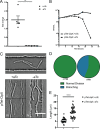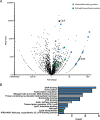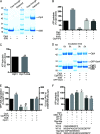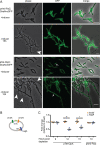ClpX Is Essential and Activated by Single-Strand DNA Binding Protein in Mycobacteria
- PMID: 33229461
- PMCID: PMC7847540
- DOI: 10.1128/JB.00608-20
ClpX Is Essential and Activated by Single-Strand DNA Binding Protein in Mycobacteria
Abstract
The ClpP1P2 proteolytic complex is essential in Mycobacterium tuberculosis Proteolysis by ClpP1P2 requires an associated ATPase, either ClpX or ClpC1. Here, we sought to define the unique contributions of the ClpX ATPase to mycobacterial growth. We formally demonstrated that ClpX is essential for mycobacterial growth, and to understand its essential functions, we identified ClpX-His-interacting proteins by pulldown and tandem mass spectrometry. We found an unexpected association between ClpX and proteins involved in DNA replication, and we confirm a physical association between ClpX and the essential DNA maintenance protein single-stranded-DNA binding protein (SSB). Purified SSB is not degraded by ClpXP1P2; instead, SSB enhances ATP hydrolysis by ClpX and degradation of the model substrate GFP-SsrA by ClpXP1P2. This activation of ClpX is mediated by the C-terminal tail of SSB, which had been implicated in the activation of other ATPases associated with DNA replication. Consistent with the predicted interactions, depletion of clpX transcript perturbs DNA replication. These data reveal that ClpX participates in DNA replication and identify the first activator of ClpX in mycobacteria.IMPORTANCE Tuberculosis, caused by Mycobacterium tuberculosis, imposes a major global health burden, surpassing HIV and malaria in annual deaths. The ClpP1P2 proteolytic complex and its cofactor ClpX are attractive drug targets, but their precise cellular functions are unclear. This work confirms ClpX's essentiality and describes a novel interaction between ClpX and SSB, a component of the DNA replication machinery. Further, we demonstrate that a loss of ClpX is sufficient to interrupt DNA replication, suggesting that the ClpX-SSB complex may play a role in DNA replication in mycobacteria.
Keywords: DNA replication; cell cycle; mycobacteria; protein degradation.
Copyright © 2021 Kester et al.
Figures




Similar articles
-
The Mycobacterium tuberculosis ClpP1P2 Protease Interacts Asymmetrically with Its ATPase Partners ClpX and ClpC1.PLoS One. 2015 May 1;10(5):e0125345. doi: 10.1371/journal.pone.0125345. eCollection 2015. PLoS One. 2015. PMID: 25933022 Free PMC article.
-
Substrate delivery by the AAA+ ClpX and ClpC1 unfoldases activates the mycobacterial ClpP1P2 peptidase.Mol Microbiol. 2014 Aug;93(4):617-28. doi: 10.1111/mmi.12694. Epub 2014 Jul 13. Mol Microbiol. 2014. PMID: 24976069 Free PMC article.
-
Acyldepsipeptide antibiotics kill mycobacteria by preventing the physiological functions of the ClpP1P2 protease.Mol Microbiol. 2016 Jul;101(2):194-209. doi: 10.1111/mmi.13362. Epub 2016 Apr 1. Mol Microbiol. 2016. PMID: 26919556 Free PMC article.
-
[Bacterial ClpX protease structure and function--a review].Wei Sheng Wu Xue Bao. 2010 Oct;50(10):1281-7. Wei Sheng Wu Xue Bao. 2010. PMID: 21141460 Review. Chinese.
-
ClpP: a structurally dynamic protease regulated by AAA+ proteins.J Struct Biol. 2012 Aug;179(2):202-10. doi: 10.1016/j.jsb.2012.05.003. Epub 2012 May 14. J Struct Biol. 2012. PMID: 22595189 Review.
Cited by
-
Mycobacterium abscessus DosRS two-component system controls a species-specific regulon required for adaptation to hypoxia.Front Cell Infect Microbiol. 2023 Mar 9;13:1144210. doi: 10.3389/fcimb.2023.1144210. eCollection 2023. Front Cell Infect Microbiol. 2023. PMID: 36968107 Free PMC article.
-
The Bacterial ClpXP-ClpB Family Is Enriched with RNA-Binding Protein Complexes.Cells. 2022 Aug 2;11(15):2370. doi: 10.3390/cells11152370. Cells. 2022. PMID: 35954215 Free PMC article. Review.
-
The ClpXP protease and the ClpX unfoldase control virulence, cell division, and autolysis in Streptococcus pneumoniae.Microbiol Spectr. 2025 Jul;13(7):e0080425. doi: 10.1128/spectrum.00804-25. Epub 2025 May 23. Microbiol Spectr. 2025. PMID: 40407370 Free PMC article.
-
Subtractive proteomics and reverse-vaccinology approaches for novel drug targets and designing a chimeric vaccine against Ruminococcus gnavus strain RJX1120.Front Immunol. 2025 Apr 14;16:1555741. doi: 10.3389/fimmu.2025.1555741. eCollection 2025. Front Immunol. 2025. PMID: 40297578 Free PMC article.
-
Control of Toxin-Antitoxin Systems by Proteases in Mycobacterium Tuberculosis.Front Mol Biosci. 2021 May 17;8:691399. doi: 10.3389/fmolb.2021.691399. eCollection 2021. Front Mol Biosci. 2021. PMID: 34079824 Free PMC article. Review.
References
Publication types
MeSH terms
Substances
Grants and funding
LinkOut - more resources
Full Text Sources
Other Literature Sources

